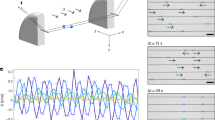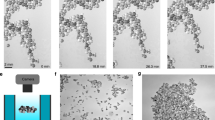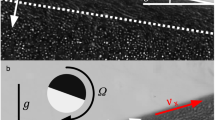Abstract
In many situations in which droplets wet fibres, wind is present. Large nets are used to harvest fog transported by coastal breezes from the ocean1,2 and noxious aerosols are contained in chemical plants by driving them across fibrous filters3,4. In glass wool factories, thin fibres are subjected to airflows as they are simultaneously sprayed with resin to glue them together5,6. The control and reconfiguration of the liquid in these situations is essential. It can be set geometrically, as is the case for assemblies of non-parallel fibres6,7 or tapered cylinders8,9,10,11, but the wind itself may also be exploited for this purpose4,12,13. Here, we show that a transverse wind can induce directional motion of droplets along horizontal fibres—even upwind if the fibre is tilted—and generate strong repulsive interactions between droplets. All of these effects are interpreted as consequences of asymmetric wakes behind the liquid.
This is a preview of subscription content, access via your institution
Access options
Access Nature and 54 other Nature Portfolio journals
Get Nature+, our best-value online-access subscription
$29.99 / 30 days
cancel any time
Subscribe to this journal
Receive 12 print issues and online access
$209.00 per year
only $17.42 per issue
Buy this article
- Purchase on Springer Link
- Instant access to full article PDF
Prices may be subject to local taxes which are calculated during checkout




Similar content being viewed by others
Data availability
The data that support the plots within this paper and other findings of this study are available in the main text and Supplementary Information. Additional information is available from the authors on reasonable request.
References
Klemm, O. et al. Fog as a fresh-water resource: overview and perspectives. AMBIO 41, 221–234 (2012).
Park, K. C., Chhatre, S. S., Srinivasan, S., Cohen, R. E. & McKinley, G. H. Optimal design of permeable fiber network structures for fog harvesting. Langmuir 29, 13269–13277 (2013).
Agranovski, I. E. & Braddock, R. D. Filtration of liquid aerosols on wettable fibrous filters. AIChE J. 44, 2775–2783 (1998).
Mullins, B. J., Braddock, R. D., Agranovski, I. E. & Cropp, R. A. Observation and modelling of barrel droplets on vertical fibres subjected to gravitational and drag forces. J. Coll. Int. Sci. 300, 704–712 (2006).
Bajcar, T., Blagojevic, B., Sirok, B. & Dular, M. Influence of flow properties on a structure of a mineral wool primary layer. Exp. Therm. Fluid Sci. 32, 440–449 (2007).
Duprat, C., Protière, S., Beebe, A. Y. & Stone, H. A. Wetting of flexible fibre arrays. Nature 482, 510–513 (2012).
Gilet, T., Terwagne, D. & Vandewalle, N. Droplets sliding on fibres. Eur. Phys. J. E 31, 253–262 (2010).
Lorenceau, É. & Quéré, D. Drops on a conical wire. J. Fluid Mech. 510, 29–45 (2004).
Zheng, Y. et al. Directional water collection on wetted spider silk. Nature 463, 640–643 (2010).
Ju, J. et al. A multi-structural and multi-functional integrated fog collection system in cactus. Nat. Commun. 3, 1247 (2012).
Lv, C. et al. Substrate curvature gradient drives rapid droplet motion. Phys. Rev. Lett. 113, 026101 (2014).
Sahu, R. P., Sinha-Ray, S., Yarin, A. L. & Pourdeyhimi, B. Blowing drops off a filament. Soft Matter 9, 6053–6071 (2013).
Fang, J., Davoudi, M. & Chase, G. G. Drop movement along a fiber axis due to pressure driven air flow in a thin slit. Sep. Purif. Technol. 140, 77–83 (2015).
Lorenceau, É., Clanet, C. & Quéré, D. Capturing drops with thin fibers. J. Coll. Int. Sci. 279, 192–197 (2004).
de Ruiter, R. et al. Buoyant droplets on functional fibers. Langmuir 28, 13300–13306 (2012).
Loth, E. Quasi-steady shape and drag of deformable bubbles and drops. Int. J. Multiph. Flow. 34, 523–546 (2008).
Shringi, D., Dwyer, H. A. & Shaw, B. D. Numerical studies of flows over liquid droplets on cylindrical fibers. Comput. Fluids 77, 1–11 (2013).
Taneda, S. Experimental investigation of the wake behind a sphere at low Reynolds numbers. J. Phys. Soc. Jpn 11, 1104–1108 (1956).
Sakamoto, H. & Haniu, H. A study on vortex shedding from spheres in a uniform flow. J. Fluids Eng. 112, 386–392 (1990).
Magarvey, R. H. & Bishop, R. L. Transition ranges for three-dimensional wakes. Can. J. Phys. 39, 1418–1422 (1961).
Ern, P., Risso, F., Fabre, D. & Magnaudet, J. Wake-induced oscillatory paths of bodies freely rising or falling in fluids. Ann. Rev. Fluid Mech. 44, 97–121 (2012).
Auguste, F. & Magnaudet, J. Path oscillations and enhanced drag of light rising spheres. J. Fluid Mech. 841, 228–266 (2018).
Mathai, V., Zhu, X., Sun, C. & Lohse, D. Flutter to tumble transition of buoyant spheres triggered by rotational inertia changes. Nat. Commun. 9, 1792 (2018).
Johnson, T. A. & Patel, V. C. Flow past a sphere up to a Reynolds number of 300. J. Fluid Mech. 378, 19–70 (1999).
Lee, S. A numerical study of the unsteady wake behind a sphere in a uniform flow at moderate Reynolds numbers. Comput. Fluids 29, 639–667 (2000).
Tomboulides, A. G. & Orzag, S. A. Numerical investigation of transitional and weak turbulent flow past a sphere. J. Fluid Mech. 416, 45–73 (2000).
Ormières, D. & Provansal, M. Transition to turbulence in the wake of a sphere. Phys. Rev. Lett. 83, 80–83 (1999).
Gumowski, K., Miedzik, J., Goujon-Durand, S., Jenffer, P. & Wesfreid, J. E. Transition to a time-dependent state of fluid flow in the wake of a sphere. Phys. Rev. E 77, 055308 (2008).
Bouchet, G., Mebarek, M. & Dušek, J. Hydrodynamic forces acting on a rigid fixed sphere in early transitional regimes. Eur. J. Mech. B 25, 321–336 (2006).
Kim, I., Elghobashi, S. & Sirignano, W. A. Three-dimensional flow over two spheres placed side by side. J. Fluid Mech. 246, 465–488 (1993).
Prahl, L. et al. On the interaction between two fixed spherical particles. Int. J. Multiph. Flow. 33, 707–725 (2007).
Hallez, Y. & Legendre, D. Interaction between two spherical bubbles rising in a viscous liquid. J. Fluid Mech. 673, 406–431 (2011).
Cao, C. et al. Simulating the interactions of two freely settling spherical particles in Newtonian fluid using lattice-Boltzmann method. Appl. Math. Comput. 250, 533–551 (2015).
Wu, J. & Manasseh, R. Dynamics of dual-particles settling under gravity. Int. J. Multiph. Flow. 24, 1343–1358 (1998).
Ern, P. & Brosse, N. Interaction of two axisymmetric bodies falling side by side at moderate Reynolds numbers. J. Fluid Mech. 741, R6 (2014).
Acknowledgements
We thank E. Wesfreid for illuminating discussions, J. Gibbons for semantic advice, C. Frot, D. Guy and A. Garcia for their help with wind tunnels, and O. Cadot for introducing us to PIV measurements. We also thank Saint-Gobain for financial support and for inspiring this work.
Author information
Authors and Affiliations
Contributions
D.Q. and P.-B.B. conceived and designed the project. P.-B.B. and H.B. performed the experiments and analyses. P.-B.B., C.C. and D.Q. built the models. P.-B.B. and D.Q. wrote the manuscript with input from the other authors.
Corresponding author
Ethics declarations
Competing interests
The authors declare no competing interests.
Additional information
Peer review information: Nature Physics thanks Marco Fontelos and the other, anonymous, reviewer(s) for their contribution to the peer review of this work.
Publisher’s note: Springer Nature remains neutral with regard to jurisdictional claims in published maps and institutional affiliations.
Supplementary information
Supplementary Information
Supplementary video captions and Figs. 1–18.
Supplementary Video 1
Self-propelling droplet on a fibre, confined between two plastic beads.
Supplementary Video 2
Self-propelling droplet at a lower wind velocity.
Supplementary Video 3
Self-propelling droplet at a slightly higher wind velocity.
Supplementary Video 4
Self-propelling droplet at higher wind velocities.
Supplementary Video 5
Self-propelling droplet in a strong wind.
Supplementary Video 6
PIV data for droplets moving to the left along the fibre.
Supplementary Video 7
PIV data for droplets moving to the right along the fibre.
Supplementary Video 8
Motion of tracers inside a droplet for weak wind.
Supplementary Video 9
Motion of tracers inside a droplet for strong wind.
Supplementary Video 10
Motion of tracers inside a droplet for strong wind.
Supplementary Video 11
Two self-propelling droplets confined between plastic beads moving in opposite directions.
Supplementary Video 12
Race between two self-propelling droplets on an initially dry fibre.
Supplementary Video 13
Five self-propelling droplets confined between two beads.
Supplementary Video 14
Transporting small solids with self-propelling droplets.
Rights and permissions
About this article
Cite this article
Bintein, PB., Bense, H., Clanet, C. et al. Self-propelling droplets on fibres subject to a crosswind. Nat. Phys. 15, 1027–1032 (2019). https://doi.org/10.1038/s41567-019-0599-0
Received:
Accepted:
Published:
Issue Date:
DOI: https://doi.org/10.1038/s41567-019-0599-0
This article is cited by
-
Honeybee comb-inspired stiffness gradient-amplified catapult for solid particle repellency
Nature Nanotechnology (2024)
-
How drops of liquid move along parallel fibres in a perpendicular airflow
Nature Physics (2023)
-
Aerodynamic interactions of drops on parallel fibres
Nature Physics (2023)



